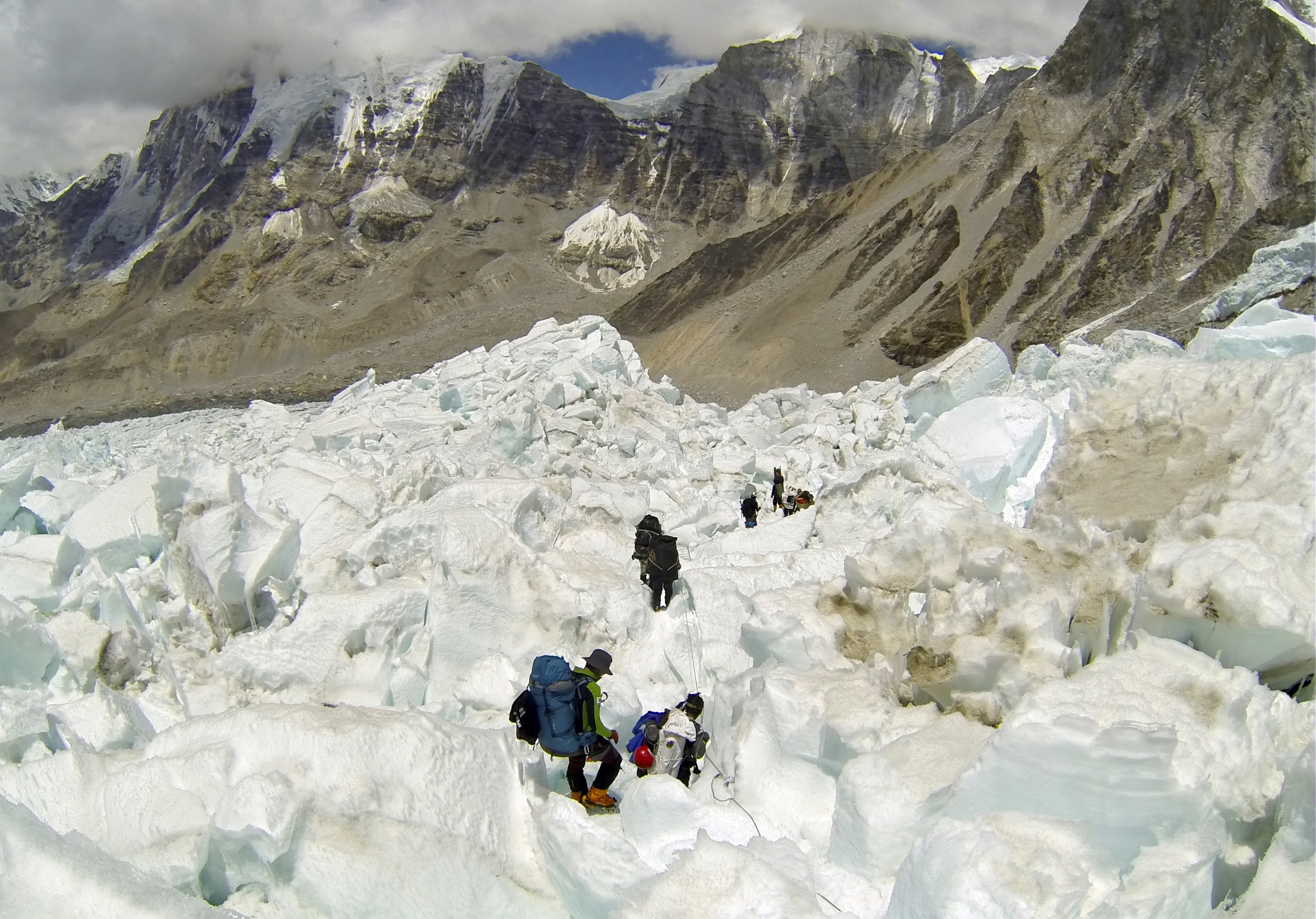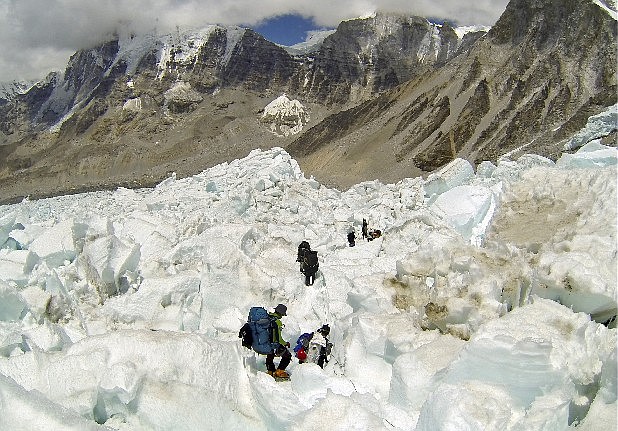 Climbers descend Khumbu Icefall on their way back to Base Camo after summitting the 29,035-foot summit of Mount Everest. With its dreams of covering a daredevil's attempt to jump off Mount Everest over, the Discovery network is instead making a documentary on the avalanche Friday that killed more than a dozen mountain guides. Discovery President Eileen O'Neill said Tuesday, April 22, the network hopes to air the film within the next few weeks. Discovery will encourage viewers to donate to a relief fund for families of the Sherpa guides killed in the disaster. Several of the Sherpas killed were helping prepare for American Joby Ogwyn's planned jump from the summit in a wingsuit. Discovery planned to show the stunt on live television May 11.
Climbers descend Khumbu Icefall on their way back to Base Camo after summitting the 29,035-foot summit of Mount Everest. With its dreams of covering a daredevil's attempt to jump off Mount Everest over, the Discovery network is instead making a documentary on the avalanche Friday that killed more than a dozen mountain guides. Discovery President Eileen O'Neill said Tuesday, April 22, the network hopes to air the film within the next few weeks. Discovery will encourage viewers to donate to a relief fund for families of the Sherpa guides killed in the disaster. Several of the Sherpas killed were helping prepare for American Joby Ogwyn's planned jump from the summit in a wingsuit. Discovery planned to show the stunt on live television May 11.KATMANDU, Nepal - Most Sherpa mountain climbers have decided to leave Mount Everest, a guide said Tuesday, confirming a walkout certain to disrupt a climbing season that was already marked by grief over the 16 lives lost in Everest's deadliest disaster.
"It is just impossible for many of us to continue climbing while there are three of our friends buried in the snow," said Dorje Sherpa, an experienced Everest guide from the tiny Himalayan community that has become famous for its high-altitude skills and endurance.
"I can't imagine stepping over them," he said of the three Sherpa guides who remain buried in ice and snow after Friday's deadly avalanche. Thirteen bodies have been recovered.
The avalanche was triggered when a massive piece of glacier sheared away from the mountain along a section of constantly shifting ice and crevasses known as the Khumbu Icefall - a teacherous area where overhanging immensities of ice as large as 10-story buildings hang over the main route up the mountain.
Special teams of Sherpas, known as Icefall Doctors, fix ropes through what they hope to be the safest paths, and use aluminum ladders to bridge crevasses. But the Khumbu shifts so much that they need to go out every morning -- as they were doing when disaster struck Friday -- to repair sections that have broken overnight and move the climbing route if needed.
Earlier Tuesday, Nepal's government appeared to agree to some of the Sherpas' demands in the threatened boycott, such as setting up a relief fund for Sherpas who are killed or injured in climbing accidents, but the funding falls far short of the Sherpas' demands.
After the avalanche, the government quickly said it would pay the families of each Sherpa who died 40,000 rupees, or about $415. The Sherpas said they deserved far more -- including more insurance money, more financial aid for the victims' families and new regulations that would ensure climbers' rights.
On Tuesday, the government's offer was modified to include a relief fund to help Sherpas injured in mountaineering accidents and the families of those killed, and to pay for rescue during accidents on the mountain. The government said it would stock the fund annually with 5 percent of its earnings from Everest climbing fees -- well below the 30 percent the Sherpas are demanding. Nepal earns some $3.5 million annually in Everest climbing fees.
The insurance payout for those killed on the mountain will also be doubled to $15,620 (2 million rupees), the Ministry of Tourism said -- far short of the Sherpas' demand for $20,800.
The walkout decision was made after a memorial service at base camp for the victims, Dorje Sherpa said, adding that most guides were planning to pack up and leave as early as Wednesday.
"We want to honor the members we lost and out of respect for them we just can't continue," he said.
Most attempts to reach the summit are made in mid-May, when weather is most favorable. If the Sherpas boycott the season, many climbers will have to forfeit most or all of the money they have spent to go up Everest -- at a cost of $75,000 or more.
The Nepal National Mountain Guide Association will try to negotiate with the Sherpas and the government because a total boycott would harm Nepal's mountaineering in the long term, the group's general secretary, Sherpa Pasang, said.
While most climbers have to make multiple passes through the Icefall, moving up and down the mountain as they acclimatize and prepare for their summit attempt, Sherpas make the dangerous journey two dozen times or more, carrying supplies and helping clients negotiate the hazardous maze of ice.
"We look up at these chunks of ice blocks, pray and then try to get out of the area as fast as we can," said 34-year-old Nima Sherpa, who did not make the ascent this season.
Thousands of Nepali guides and porters make their livelihoods during the climbing season, when climbers rely on them for everything from carrying gear and cooking food to high-altitude guiding; without them, reaching the summit would be almost impossible.
Nearly 30 climbers have died on the Icefall since 1963, most killed in avalanches or when they were crushed by huge chunks of ice. Occasionally, things are so dangerous the guides turn away completely. In 2012, one of the best-known Everest guiding operations, Himalayan Experience, run by New Zealand mountaineer Russell Brice, canceled its climb midway through the season, saying the Icefall was simply too dangerous.
At the base camp memorial service Tuesday, Buddhist priests read religious scripts, and Sherpas and foreign climbers burned incense butter lamps and prayed for the dead. The victims' bodies were cremated on Monday.
Since the avalanche, expedition teams have declared a week of mourning. About 400 foreign climbers from 39 expedition teams were on the mountain with an equal number of Sherpa guides, along with many more support staff such as cooks, cleaners and porters in the base camp.
At least one expedition company has canceled this season's attempt for its six-member team.
"Our team members have empathy for the Sherpa community and we wish for everyone to be able to mourn their lost family and friends in peace," the Adventure Consultants Everest Expedition 2014 Team said on its website.
More than 4,000 climbers have reached the top of the world's highest mountain since 1953, when it was first conquered by New Zealander Edmund Hillary and Sherpa Tenzing Norgay. Hundreds of people have died trying.
